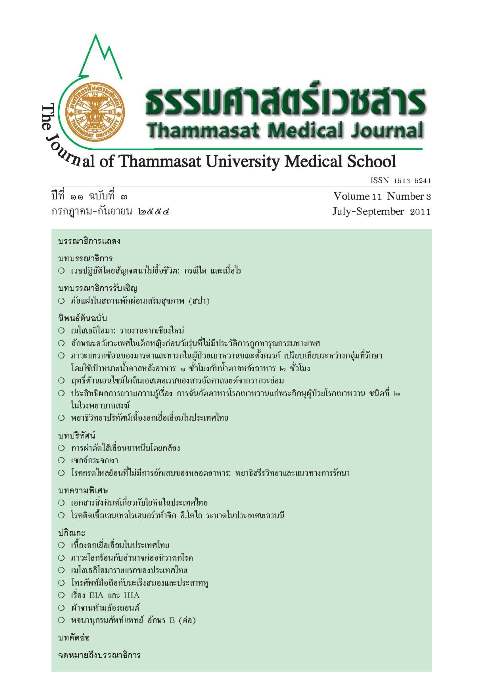Effectiveness of chronic patient care at Kukot Primary Care Center
Keywords:
ประสิทธิผล, การดูแลผู้ป่วยโรคเรื้อรัง, ศูนย์แพทย์ปฐมภูมิ, effectiveness, chronic patient care, Primary Medical CenterAbstract
Objective: To study the practice characteristics, patient compliance, health outcomes and a unit cost of chronic disease care at the Kukot university primary care center (UPCC), Thammasat.
Method: A cross-sectional analytical descriptive study. Retrieved 2-years back-data from randomly selected medical records of 603 chronic disease patients attending the UPCC during August to October 2007.
Results: A sample of 184 cases were analyzed comprising 30.1% of total period cases. Seventy fi ve percent of the samples were females of mean age 62 ± 10.02 years. Diagnoses were type 2 diabetes 47.8% and 52.2% hypertensives. Patients with good compliance, comprised 85.9%. Of the diabetes 100% had plasma glucose measured >/= 4 times per year; 75, 96.5 and 95.5% had HbA1c, serum creatinine and serum lipids level determined at least once in the 2 years period. Fifty-one percent had urine analysis at least once and 17.4% found proteinuria. Fifty-eight percent had eye examination at least once and 29.4% suffered diabetic retinopathy. There were records on numbness or “pins and needles” at hands and feet and records on foot examination in 48.9 and 12.5% respectively. Of the hypertensives 16.7% had EKG performed once at the initial diagnosis. Ninety-one percent had been serially followed for other modifi able cardiovascular risks such as serum glucose, serum lipids, serum creatinine and urine analysis. Pre-defi ned health outcome indicators included systolic and diastolic blood pressures, serum levels of HbA1c, lipids, creatinine, liver enzymes. There were no signifi cant difference between the means of these parameters at the fi rst and the last trimester of the 2 years (p > .05). The unit cost of this group was 701 Baht per year.
Conclusion: Chronic disease patients attending this UPCC had similar patient profi les as other public health primary care units. The practice characteristics found highly complied with the practice guideline used in Thailand although there were high variations among the practicing primary care physicians. Improvement of health as shown by predefi ned health parameters was not clearly seen. The system of chronic care electronic medical records would greatly facilitate the practicing physicians as well as the cost containment.
Key words: effectiveness, chronic patient care, Primary Medical Center


